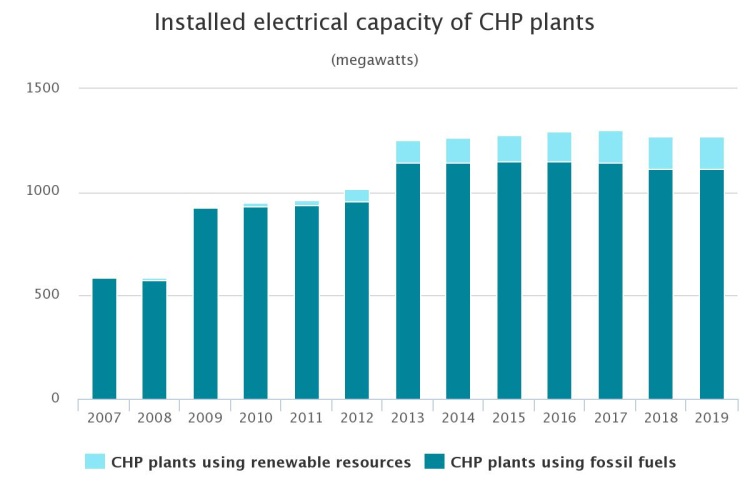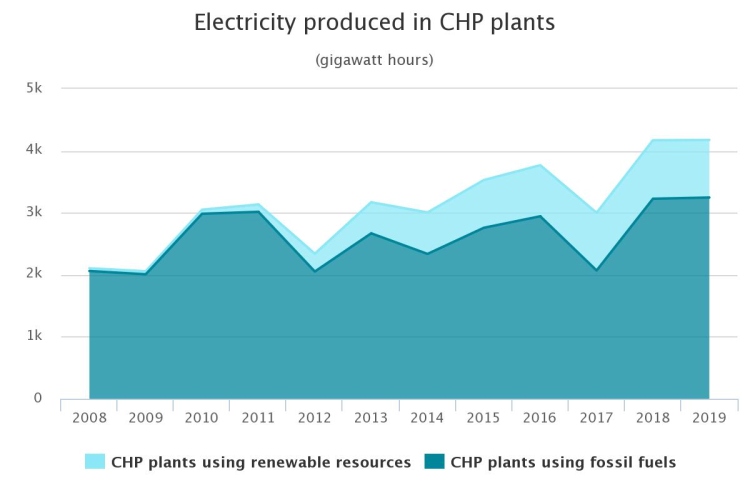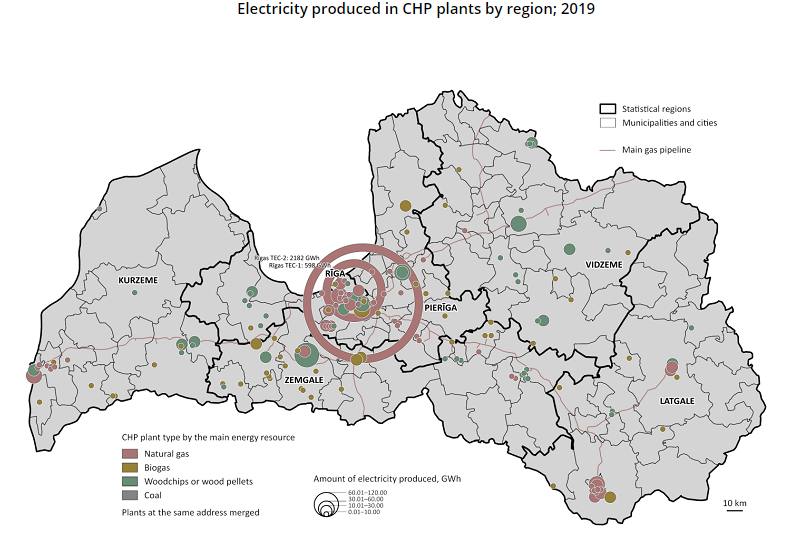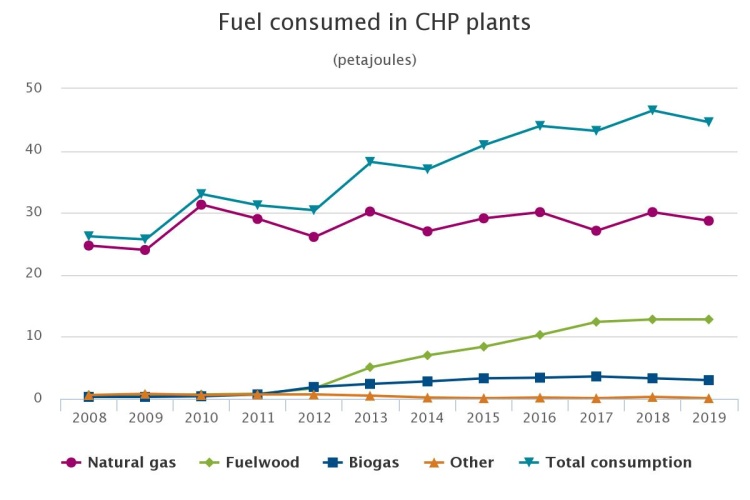Analytics, Ecology, Energy, Latvia, Statistics
International Internet Magazine. Baltic States news & analytics
Thursday, 18.12.2025, 01:38
In 2019, level of electricity produced in CHP plants in Latvia remained high
 Print version
Print versionIn 2019, CHP plants produced
4 173.7 gigawatt hours (GWh) of electricity, which is 3.7 GWh
more, compared to 2018 (4 170.0 GWh). Average amount of electricity
produced in CHP plants over the last two years was 33.5% higher as compared to
the average output of electricity in CHP plants in period from 2010 to 2017.
Electricity produced in CHP plants in 2018 and 2019 on average comprised 63.4%
of total amount of electricity produced in the country, which is
13.1 percentage point more as compared to the average share from 2010 to
2017 – 50.3%. Rise of indicators was promoted by smaller output of electricity
in hydro power plants, which was significantly affected by lower water inflow
in river Daugava.

Last year, CHP plants produced 5 383.0 GWh
of heat, which is 8.6% less, compared to 2018. The amount of heat produced in
CHP plants in 2019 constituted 67.7% of the total heat generated in Latvia.
Indicators characterizing
activities of CHP plants in 2019
|
Installed electrical capacity of CHP plants |
Number of CHP plants |
Installed electrical capacity, MW |
Electricity produced, GWh |
Heat produced, GWh |
|
|
|
|||||
|
Total |
175 |
1 269.7 |
4 173.7 |
5 383.0 |
|
|
≤ 0.2 MW |
22 |
3.1 |
16.0 |
29.1 |
|
|
0.2 < P* ≤ 0.5 MW |
28 |
9.8 |
57.1 |
264.8 |
|
|
0.5 < P ≤ 1 MW |
67 |
55.6 |
333.2 |
603.8 |
|
|
1 < P ≤ 5 MW |
51 |
125.7 |
735.0 |
1 955.2 |
|
|
5 < P ≤ 20 MW |
3 |
27.7 |
103.9 |
163.5 |
|
|
> 20 MW |
4 |
1 047.8 |
2 928.5 |
2 366.6 |
|
*P – electrical capacity
In 2019 total electrical capacity of CHP plants reached 1 269.7 MW, which has not changed significantly since 2013, but over the ten year period from 2010 to 2019 electrical capacity of CHP plants has increased 1.3 times.

In 2019 electrical capacity of public3 CHP plants comprised 98% of the total electrical capacity of CHP plants, and over the ten years level of this indicator has not fluctuated a lot. Four public CHP plants with capacity that is larger than 20 MW comprised 36% of the total electrical power in the country: three of them are active in Riga, one – in Zemgale region.
As share of electrical capacity in CHP plants fuelled by fossil fuels has reduced gradually,over the ten years share of electrical capacity in CHP plants fuelled by renewable energy sources (RES) has increased by 10.8 percentage points and comprised 12.4% of the total electrical capacity of CHP plants in 2019. As compared to the previous year, in 2019 electrical capacity of RES-fuelled CHP plants was 0.3 MW less, comprising 157.6 MW.

The largest share of electrical capacity of CHP plants using fossil fuels in 2019 was in Riga and Latgale region – respectively, 99% and 72% of the total electrical capacity of CHP plants in the region (in Riga region – 1 059.5 MW, in Latgale region – 40.8 MW). The largest share of electrical capacity of RES-fuelled CHP plants was in Vidzeme (98%) and Zemgale (91%) region, where total electrical capacity was 29.0 MW and 62.5 MW, respectively. Share of electrical capacity of RES-fuelled CHP plants in Kurzeme and Pierīga region was 74% and 60% of the total electrical capacity of CHP plants, respectively – 26.3 MW in Kurzeme and 51.6 MW in Pierīga region.
In 2019, amount of electricity produced from RES in CHP plants comprised 927.4 GWh, which is 1.7% less than in the previous year. Drop of electricity (of 5.6%) was observed in biogas CHP plants, but rise (of 0.9%) – in biomass CHP plants. Over the last five years from 2015 to 2019 output of electricity of RES-fuelled CHP plants has grown by 20.5%, but over the last ten years – 14 times. Rise of electricity produced from RES in CHP plants is promoted by state support programmes.
Over the last five years electricity produced from RES in CHP plants on average comprised 24% both of total generation of electricity in CHP plants and of total generation of public electricity produced from RES.

In 2019, Latvian CHP plants mainly consumed natural gas (28.7 petajoules (PJ)) and fuelwood (12.8 PJ). Over the ten-year period, the share of natural gas consumed in CHP plants has dropped from 95% to 64%, while the share of RES has gone up notably, reaching 36% in 2019.
Latvia aims4 at reaching 40% of RES in the gross final energy consumption and reducing Latvian energy dependency upon energy imports in 2020. The share of RES in Latvian final energy consumption accounted for 40% in 2018.
Information on activity of CHP plants will be published on 19 June in the CSB database section „Environment and energy”.
Methodological explanations
1Cogeneration (combined heat and power production) – simultaneous generation of electricity and heat in the same technological device and cycle using natural gas, biogas, solid fuels, liquid fuels and fuelwood.
2A CHP plant consists of CHP units and heat peak load boiler units.
3Public CHP plants whose main activity is production of electricity and heat (NACE Rev. 2, section 35 "Electricity, gas, steam and air conditioning supply").
4Order of the Cabinet No 129 “On the Energy Development Guidelines for 2016-2020”
- 28.01.2022 BONO aims at a billion!
- 25.01.2021 Как банкиры 90-х делили «золотую милю» в Юрмале
- 30.12.2020 Накануне 25-летия Балтийский курс/The Baltic Course уходит с рынка деловых СМИ
- 30.12.2020 On the verge of its 25th anniversary, The Baltic Course leaves business media market
- 30.12.2020 Business Education Plus предлагает анонсы бизнес-обучений в январе-феврале 2021 года
- 30.12.2020 Hotels showing strong interest in providing self-isolation service
- 29.12.2020 В Латвии вводят комендантский час, ЧС продлена до 7 февраля
- 29.12.2020 В Rietumu и в этот раз создали особые праздничные открытки и календари 2021
- 29.12.2020 Latvia to impose curfew, state of emergency to be extended until February 7
- 29.12.2020 Linde Gas открывает завод в Кедайняйской СЭЗ








 «The Baltic Course» Is Sold and Stays in Business!
«The Baltic Course» Is Sold and Stays in Business!

